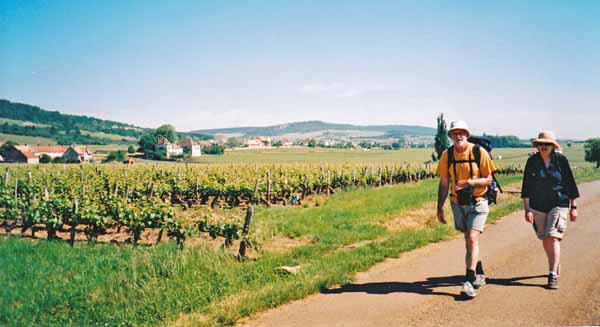
Wednesday, 26 May 2004
Distance 18 km
Duration 4 hours 0 minutes
Ascent 254 m, descent 300 m
Map 3025 OT in the TOP25series (Beaune-Chagny)
Another comfortable night on the yielding turf of France had removed all tiredness from our bones and we left the camping ground at 7:30, past the office which was no more lively looking than it had been when we arrived.
The virtues of an early start had been impressed on our minds by the afternoon heat yesterday.
We were soon climbing the vine-covered slope to the west of the town on a small bitumen road, looking back on the houses lost in the pearly morning mist. Our only company was a man on a tractor ploughing green manure into the ground.

At the top of the rise, the vines gave way to dense, tangled woodland, through which a stony footpath meandered. Once again we were on the GR76, with its reassuring markers, and after a while we came out of the forest and scrambled steeply down to Gamay.
Despite the fact that it has given its name to one of the most widely-used grape varieties in France (often used in Beaujolais wines), Gamay is no more than a few houses, with even fewer people.

Maybe we missed something, but we were not worried, as the bigger town of Chassagne-Montrachet was not far away and we looked forward to morning coffee there.
Crossing the highway we pressed on across an open valley ribbed with vines, a picture of Arcadian delight to the passing walker, and presently arrived at Chassagne-Montrachet.
I asked an old woman in the street where the bar was and she laughed. “There’s nothing here! Only caves (cellars)”.

It was a famous wine centre, producing some of the most expensive white wine in France, and evidently the business of buying it was far too serious to mix with frivolous things like coffee-drinking. We had to content ourselves with a drink of water, propped up in the shade against a wall.
Although we had started early, the heat was catching up with us. The walking was easy but by the time we got to Remigny we were wilting. This little place, like the previous one, had all the trappings of provincial charm – a pretty bridge over the stream, an avenue of trees, flower beds, park benches, a canal – except for a café.

We had crossed the river Dheune to get there and recrossed it by a different bridge, pointed in the direction of Santenay by a man mowing his lawn.
It was only a couple more kilometres on a low-level causeway, lined with trees, until we came to the railway line and beyond it the town.
At the top of the street was a fine-looking hotel, the Lion d’Or, and we almost broke into a run to get to it. We sank into chairs under the awning and ordered large coffees, the first of the day for us all.
It was almost noon and we could see the local farmworkers inside at a long table tucking into lunch, which consisted of great platters of meat and vegetables with jugs of red wine, a noisy and festive scene.
We had our own quiet picnic in a small park nearby, sitting and later lying on the grass in the shade. Then we got a room at the hotel for Max and Sue and continued in the direction of the camping ground which, as at Savigny, was a surprisingly long way out of the village to the west.
We passed a few houses and a magnificent retirement home for railway workers before we got there. Of course there was nobody at the reception, but there were plenty of pasty-faced Dutch and Germans (as pasty-faced as us) with huge vans.
Revived by showers, in clean clothes and without our packs, we strolled back to find the others, who were bent over beers on the hotel terrace.
We indulged in a little light tourism by walking up to the windmill above the town. Apart from the absence of fabric on the sails, it was in excellent order, good enough to press into service again when the oil runs out, we thought.

Back in the village, we tested some of the regional white wine (although Santenay itself specialises in reds) and then moved to the only restaurant that was operating, le Terroir. It was 8:30 but the western sun bored in on us until we moved to another table.
We ate jambon persillé, a possibly over-rated local speciality, followed by coq au vin, and enjoyed every mouthful, including two baskets of bread, which came peeping coyly from a lace nest.
It was dark when we got back to the tent, but there was someone in the office, so we presented ourselves and paid the necessary €8. Although we have many free nights on France, we do try to pay. It is just that they make it so hard for us.
Previous day: Savigny-lès-Beaune to Meursault